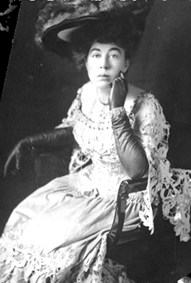Margaret Tobin Brown

Margaret Brown was accredited with commanding the lifeboat she inhabited upon the Titanic’s sinking. As captain of the lifeboat she was believed to have been responsible for the survival of all onboard the boat by steering the boat to the rescue site on the Carpathia, another ship. Once all were on the Carpathia, Brown nursed and tended to the ill (Chun). Brown’s efforts were recognized by the French Legion of Honour in 1932 and she worked to gain further support for the survivors and deceased by promoting the erection of a memorial in Washington DC and acquiring funds for the victims (Molly Brown). Brown obtained the title “unsinkable” after reporters asked her how she survived the tragedy when her response was “Typical Brown luck. We’re unsinkable (Schaeffer).”
The sinking of the Titanic contributed to Brown's fame but was not the sole cause of it. Prior to the sinking of the Titanic, Brown, known at this time as Maggie Tobin, was born into an impoverished household in America after her father fled Ireland during the Potato Famine. When she became thirteen years of age, she found work in a tobacco factory where she was exposed to horrid working conditions. Following her eighteenth year of life, Tobin moved to a mining town where she met her husband James Jacob Brown, a mining engineer. After Maggie gave birth to two children, James developed a new mining technique that instigated a vast finding of gold. The Browns were now wealthy and moved to Denver where Maggie worked for a newspaper. Maggie enjoyed learning and developed an interest in the arts. Shortly after being accepted to the Carnegie Institute, Maggie began to form an interest in politics and became active in the Women’s Suffrage Movement. Two years after the Titanic’s sinking in 1912, Maggie decided to run for the United States Senate, although unsuccessfully. She was not discouraged however, later she aided in the creation of a military regiment for women during the Mexican Revolution. She also volunteered at a hospital in France during the Great War (Schaeffer).
Maggie’s well known story regarding the Titanic and the interest people expressed in her may be attributed to her deeds prior to the ship’s destruction. Regardless of the reasons her fame was obtained, Maggie used it to aid in various causes such as the Women’s Suffrage Movement and was also known to donate money to charities. Some of the causes Maggie contributed to are quite surprising, a mining strike for instance. When confronted about the protestation of a mine Maggie replied “Normally a wife of a mine owner would not go out and help personally families of miners who were on strike. She did it for the women and children who were living in squalor and distress (Chun).” Thus Maggie did not isolate herself from those of lesser wealth than herself. This lack of isolation may not be simply due to kindness but rather an understanding developed by being raised in poverty.
During her childhood and the following years Maggie was not called Molly by anyone and it is unknown how the name “Molly” came to be synonymous with her but a likely explanation is that the media created this name for her proceeding her death in 1932 after she endured two strokes (Schaeffer).
